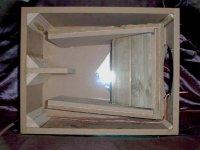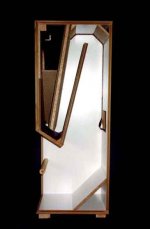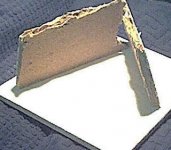In the process of the final assembly of the Sachiko speakers. Got them up and running at the moment, but have not made final decisions on damping material.
At the moment I have two inches of Dacron batting on the top/bottom and rear wall of the compression chamber. I also inserted a think 1/2 sheet at the back end of the throat to the horn to filter out some low level vocal information that was making it out of the horn.
Trying to determine if there are any alternate damping materials that would result in better performance in this application.
Parts Express makes a product called Sonic Barrier, that looks to be of similar construction to Black Hole 5. Its only a three layer design, versus four of the BH5, but its far more reasonably priced.
The question is this. Is there any negative effects to driver performance using this kind of material in the compression chamber? I understand that it performs well in a bass reflex design, but does it change the loading on the driver at all by the compression chamber?
Curious to know what materials others may have experimented with in a back loaded horn cabinet.
Regards
Mister Pig
At the moment I have two inches of Dacron batting on the top/bottom and rear wall of the compression chamber. I also inserted a think 1/2 sheet at the back end of the throat to the horn to filter out some low level vocal information that was making it out of the horn.
Trying to determine if there are any alternate damping materials that would result in better performance in this application.
Parts Express makes a product called Sonic Barrier, that looks to be of similar construction to Black Hole 5. Its only a three layer design, versus four of the BH5, but its far more reasonably priced.
The question is this. Is there any negative effects to driver performance using this kind of material in the compression chamber? I understand that it performs well in a bass reflex design, but does it change the loading on the driver at all by the compression chamber?
Curious to know what materials others may have experimented with in a back loaded horn cabinet.
Regards
Mister Pig
One of those things that's suck-it-&-see TBH. I have no idea how you would define 'better', so YMMV. There's nothing wrong with the dacron.
Incidentally, FYI, back-horns (with a tiny handful of exceptions) do not really have a compression chamber per se. The room they are sitting in is their compression chamber. They generally do possess a low-pass filter chamber though.
Incidentally, FYI, back-horns (with a tiny handful of exceptions) do not really have a compression chamber per se. The room they are sitting in is their compression chamber. They generally do possess a low-pass filter chamber though.
"The room they are sitting in"
Seems to me that we could change all sorts of "passive" components; caps, transformers and so on. We could try a SE amp or a PP....and so on...el34's 300b's....and of course we can play with stuffing in the cabinets... but i have found REALLY BIG changes to the quality of the sound by opening the windows or adding some bass absorbers to the room or (something i have tried with all the speaker amp combinations i have owned) taking them outside and setting them up in the garden. The combination of the room and the speaker is so important.
Sorry...hope this comment is not entirely out of place...
Seems to me that we could change all sorts of "passive" components; caps, transformers and so on. We could try a SE amp or a PP....and so on...el34's 300b's....and of course we can play with stuffing in the cabinets... but i have found REALLY BIG changes to the quality of the sound by opening the windows or adding some bass absorbers to the room or (something i have tried with all the speaker amp combinations i have owned) taking them outside and setting them up in the garden. The combination of the room and the speaker is so important.
Sorry...hope this comment is not entirely out of place...
Damping material is a very personal matter, its best to try and keep trying differing amounts /locations until you get the sound you like, the less the better. Ensure the speakers have broken in before trying to adjust the damping otherwise its a moving target
Keep damping away from the filter chamber path.
One of the main uses of damping material in most cases (such as this) is controlling reflections and to effectively control them, damping should be fairly central. Think behind the cone. I usually make a "ball" of damping material and "hang" it in the centre of the enclosure, thats where the reflections are meeting and causing the most problems.
Keep damping away from the filter chamber path.
One of the main uses of damping material in most cases (such as this) is controlling reflections and to effectively control them, damping should be fairly central. Think behind the cone. I usually make a "ball" of damping material and "hang" it in the centre of the enclosure, thats where the reflections are meeting and causing the most problems.
Pardon my jumping in, but I believe what hm is calling softfibre is close to what in the US is called "particle board," i.e. wood as opposed to stuffing material. I recently disassembled a German horn (an imported Einstein Rigoletto imitation) and got a first-hand look at this material.
http://www.diyaudio.com/forums/full-range/112744-soft-fiberboard-help-please-2.html
see post # 13
I call particle board a totally different material, what I refer to as particle board is "large wood chips" bonded together with glue and heat and sold in the usual 4' X 8' sheet size.
Softfibre is more like MDF which has gotten wet and expanded but not broken, IOW it is very soft and can be broken by hand.
Horst, I do not think the Softfibre would work here because it would change the chamber volume too much. I think the speaker would need a total redesign to accomodate it.
Andrew
see post # 13
I call particle board a totally different material, what I refer to as particle board is "large wood chips" bonded together with glue and heat and sold in the usual 4' X 8' sheet size.
Softfibre is more like MDF which has gotten wet and expanded but not broken, IOW it is very soft and can be broken by hand.
Horst, I do not think the Softfibre would work here because it would change the chamber volume too much. I think the speaker would need a total redesign to accomodate it.
Andrew
Last edited:
Hi Andrewbee,
Aha! Okay, I stand corrected. The stuff inside my German horns is definitely closer to particle board, and from hm's pictures, I incorrectly thought they were the same stuff. However, you are correct -- looking close-up, it's not particle board:
http://www.hm-moreart.de/schalmeihartgasbiker.jpg
My apologies!
Aha! Okay, I stand corrected. The stuff inside my German horns is definitely closer to particle board, and from hm's pictures, I incorrectly thought they were the same stuff. However, you are correct -- looking close-up, it's not particle board:
http://www.hm-moreart.de/schalmeihartgasbiker.jpg
My apologies!
Hello,
andrew you wrote (Schalmei):
"The board I get here is made by a company called "cellotex" (sp). Its also known as "hushboard" and probably other names as well. It looks similar to mdf that got
wet and expanded and breaks pretty easily."
right,
here a link i hope it works in english:
Produkte Detail - PAVATEX-Standard Dämmplatten
and look at "about what" in the middle a pic, on my HP
andrew you wrote (Schalmei):
"The board I get here is made by a company called "cellotex" (sp). Its also known as "hushboard" and probably other names as well. It looks similar to mdf that got
wet and expanded and breaks pretty easily."
right,
here a link i hope it works in english:
Produkte Detail - PAVATEX-Standard Dämmplatten
and look at "about what" in the middle a pic, on my HP
Sonic Barrier Installed
Well I had ordered one sheet of the 3/4 inch Sonic Barrier material, and I installed it in the Sachiko. One 18 by 24 inch sheet will do the driver chamber top/bottom walls and the panels behind the speaker. There is not enough to do the sides of the chamber.
Previously I have installed one thin sheet of 1/2 inch dacron into the back of the horn mouth to remove some of the lower register vocals that was making its way through the horn.
The initial results were tighter bass, with a removal of the mid bass bump that was present with only dacron in the chamber. The imaging improved, and the sound is properly balanced from side to side. Initial impressions are that the dampening material does its job, and there appears to be no ill effects from its use.
With that said, I do not have near enough hours on the drivers. The sound is still somewhat constrained, and the upper midrange/lower treble could stand to be a bit more prominent. Although the sound is listenable, and I can start putting time on the drivers.
I had not ordered the correct amount of wire, so I was waiting for some Cardas SE 15 to arrive. It showed up the other day, so I can now get it and the binding posts installed. Currently I have a complete run of 12 awg Monarchy Ohno Continuous Cast Copper wire run from the amp to the drivers.
So this project is far from complete, although the initial results look promising.
The Sonic Barrier appears to work as advertised, and seems to be a fairly priced product for what it accomplishes.
Regards
Mister Pig
Well I had ordered one sheet of the 3/4 inch Sonic Barrier material, and I installed it in the Sachiko. One 18 by 24 inch sheet will do the driver chamber top/bottom walls and the panels behind the speaker. There is not enough to do the sides of the chamber.
Previously I have installed one thin sheet of 1/2 inch dacron into the back of the horn mouth to remove some of the lower register vocals that was making its way through the horn.
The initial results were tighter bass, with a removal of the mid bass bump that was present with only dacron in the chamber. The imaging improved, and the sound is properly balanced from side to side. Initial impressions are that the dampening material does its job, and there appears to be no ill effects from its use.
With that said, I do not have near enough hours on the drivers. The sound is still somewhat constrained, and the upper midrange/lower treble could stand to be a bit more prominent. Although the sound is listenable, and I can start putting time on the drivers.
I had not ordered the correct amount of wire, so I was waiting for some Cardas SE 15 to arrive. It showed up the other day, so I can now get it and the binding posts installed. Currently I have a complete run of 12 awg Monarchy Ohno Continuous Cast Copper wire run from the amp to the drivers.
So this project is far from complete, although the initial results look promising.
The Sonic Barrier appears to work as advertised, and seems to be a fairly priced product for what it accomplishes.
Regards
Mister Pig
I popped the drivers out and put 1/2" of dacron on the bottom and sides of the compression chamber... just enough.
What a difference. The midbass is much tighter now. Kick drums are more prominent, and different bass guitars have a much more unique sound from one another. Definitely the largest improvement in sound since the planet 10 phase plugs. It seems like any speck of treble garbage making it to the horn mouth has all but disappeared.
I wouldn't go more than the 1/2", btw. I can see adverse effects if you severely restricted the path for the low bass. It could effectively act as a bass-trap if packed in there too tight. You tune to the room - not like these puppies are going to be moving very often!
What a difference. The midbass is much tighter now. Kick drums are more prominent, and different bass guitars have a much more unique sound from one another. Definitely the largest improvement in sound since the planet 10 phase plugs. It seems like any speck of treble garbage making it to the horn mouth has all but disappeared.
I wouldn't go more than the 1/2", btw. I can see adverse effects if you severely restricted the path for the low bass. It could effectively act as a bass-trap if packed in there too tight. You tune to the room - not like these puppies are going to be moving very often!
Last edited:
- Status
- This old topic is closed. If you want to reopen this topic, contact a moderator using the "Report Post" button.
- Home
- Loudspeakers
- Full Range
- Question About The Effects of Damping Materials In the Compression Chamber of a BLH


